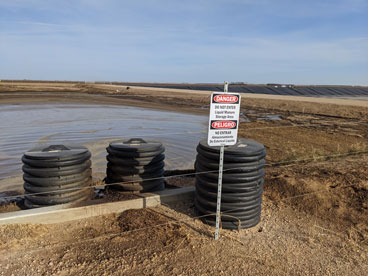By Chryseis Modderman, U of MN Extension
March 2021
As we begin to think about spring manure applications, it is important to keep safety in mind. Working with manure presents some special safety challenges beyond the basic farm dangers of working with large machinery, stress, and fatigue. One of those challenges is harmful manure gases.
Manure gas safety risks
The first step to manure gas safety is to understand the risks. In most operations, hydrogen sulfide and methane are of the biggest concern. Other gases such as ammonia, carbon dioxide, and carbon monoxide can also cause health concerns but can be more easily managed through ventilation and equipment upkeep.

Hydrogen sulfide is a colorless gas created during anaerobic (low/no oxygen) decomposition of manure which is most commonly found in liquid storage pits. It accumulates in the manure and is then released during agitation and pumping. Though it can smell like rotten eggs, you can’t solely trust your nose since your sense of smell becomes dulled to persistent odors. Levels as low as 0.1 ppm can cause eye irritation, and death can occur at just 200 ppm if there is extended exposure. Hydrogen sulfide is also dangerous because it can cause unconsciousness that can lead to drowning if near the pit, fall injury, and prolonged exposure that can cause lung damage and even death. Keep in mind that high levels of this gas don’t just occur in deep pits or in confinement; open pits can also accumulate high hydrogen sulfide levels since it tends to hang near the ground.
Methane is also a colorless gas that is heavier than air and is created by manure decomposition. While the gas itself is not typically toxic, it can cause asphyxiation as it displaces oxygen and breathable air. The other concern with methane is that it’s highly flammable. When levels reach 5 to 15% by volume, fires and explosions become a hazard. It is also quite mobile and can accumulate in unexpected areas, so ignition points far across the barn from the agitated manure can still pose a threat.
Safety tips
To avoid the above risks, develop safety protocols for your farm or operation when it comes to handling manure, especially activities like agitation and pumping. When working with manure, ask yourself the following questions:
Agitation and pumping:
- Are livestock and personnel removed from the manure basin area where they might inhale dangerous gases?
- Is the pit or basin well-ventilated?
- Have you disconnected any electrical equipment that may cause a spark?
- Do you have the proper personal protective equipment (self-contained breathing apparatus and harness with lifeline) on hand in case you need to enter the pit or basin?
- Do you have personal gas monitors?
- Do you have an Emergency Response Plan with updated phone numbers and contacts?
- Do you have signage or other communication measures in place to inform others that agitation and pumping are occurring?
- Have all employees and personnel been trained to follow your safety protocols and plans?

